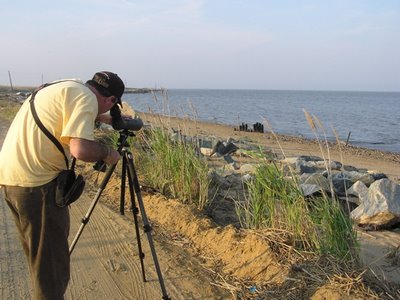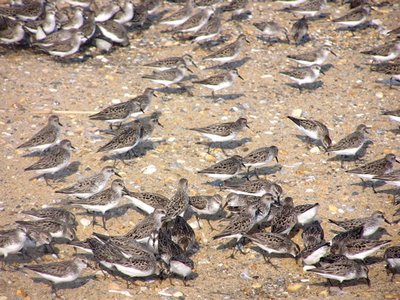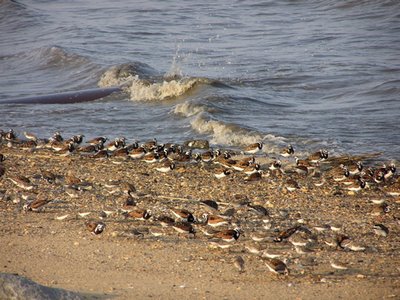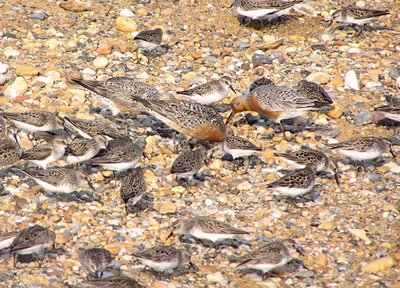 My big sweetie digiscoping. His pretty much most favorite activity.
My big sweetie digiscoping. His pretty much most favorite activity.Part of the immense attraction of Delaware Bay in late May is the concentration of shorebirds that come to feast on horseshoe crab eggs along its shores. These birds are tired and famished from flights as far away as Argentina, and they depend on the precise timing of crabspawn to replenish their wasted bodies when they arrive. Needless to say, overharvesting of horseshoe crabs has played havoc with shorebird populations worldwide, but we're beginning to wake up and protect these utterly prehistoric looking crustaceans, if only because they nourish more glamorous life forms. Each huge female lays thousands of eggs, each one no larger than a pencil point. The turnstones, knots, and peeps dig holes in the sand at the high tide line, and gobble down crab caviar as if their lives depended on it--which they do.
A river of semipalmated sandpipers
 Ruddy turnstones are so beautiful they're almost unbelievable. Why so ornate? Only the turnstones know.
Ruddy turnstones are so beautiful they're almost unbelievable. Why so ornate? Only the turnstones know.
When, when, when will we wake up and stop pulling the shorebirds' resources out from under them? When will the State of Delaware step in and at least put some signs up along this narrow strip of beach on Port Mahon Road, asking people not to walk and frighten these exhausted birds? As we watched, there was a steady stream of people blundering around amongst the flocks, forcing them away from their much-needed meals. We were told that at one time there was a guard there, asking people to respect the birds. It's the least we can do for these weary travelers. As you know, this is usually a light and cheery blog, but I feel compelled to quote Paul Baicich's excellent Swarovski Birding E-bulletin on this issue:
RED KNOT REPORT
The Red Knot predicament continues to attract increasing attention this
season. As you know, this shorebird makes a remarkable 18,000-mile
round-trip annual migration from its Arctic breeding grounds to the tip of
South America every year. Each spring, Red Knots, along with great numbers
of Ruddy Turnstones, Semipalmated Sandpipers, and Sanderlings stop on their
marathon flight to "refuel" on the beaches of Delaware Bay, specifically to
devour the eggs of the world's largest breeding aggregation of Horseshoe
Crabs.
Recently, however, the over-harvesting of the crabs has contributed to a
disturbing decline in the North American population of the Red Knot. A
drastic increase in the take of Horseshoe Crabs for use as bait in conch
pots and eel traps in the mid-1990s significantly diminished their numbers
in Delaware Bay, an activity that also resulted in a diminution of the
birds' food supply. Without the fat-rich diet of Horseshoe Crab eggs at
this major stopover site, the Red Knot's ability to complete its
long-distance migration to the Arctic is severely compromised. Red Knot
numbers in the Delaware Bay dropped from a high of perhaps 150,000 at the
end of the 1980s to about 13,000 in 2004, which some authorities suggest
could be just barely above the number needed to maintain a viable population.
Within the last year, the USFWS denied an emergency request to list the
North American race of the Red Knot as Endangered, and the final "90-day
decision" determination is now overdue. (Gee, why would we worry about a bird whose population has dropped from 150K to 13 K in 25 years? Mr. Bush, care to answer that? Didn't think so--JZ)

Red knots (the big ones with the robin-red breasts) at Port Mahon Road. There were maybe 50 birds all told. There should have been a carpet of them. Those days may be forever gone.
Last month, at the meeting of the Atlantic States Marine Fisheries
Commission (ASMFC), the Horseshoe Crab Management Board voted against
imposing a moratorium on Horseshoe Crab take in Delaware Bay. This was
actually against the wishes of Delaware and New Jersey, which both sought
the moratorium. Instead, the Board decided to adopt something called
Addendum IV to the Interstate Fishery Management Plan for Horseshoe Crabs,
which would reduce permit each state's take from 150,000 to 100,000 crabs
and limited the harvest to male crabs. The moratorium would have been an
important step toward securing the survival of the species.
Although the Board decision reduced Horseshoe Crab landings for each state,
New Jersey has wisely imposed its own moratorium, meaning that no crabs
will be taken in that state. Delaware has not decided whether it will
implement a full moratorium, but unfortunately Virginia continues to
advocate for the highest possible take of Horseshoe Crabs. At the moment,
Virginia is the largest obstacle to a moratorium.
For more information on the situation, see Defenders of Wildlife.
Off to speak at the Holden Arboretum Saturday. I'm going to poke around, hit an orchid supply house, a Trader Joe's, a Border's...all the things we have none of down here in the foothills. I'm going to take my notebook and scribble some NPR commentaries and maybe a couple of poems. Time alone, it can be a beautiful thing. See you Monday!






0 comments:
Post a Comment